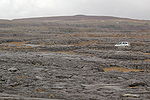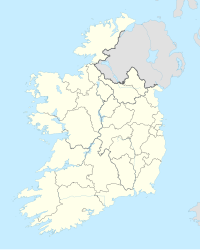The United Nations Educational, Scientific and Cultural Organization (UNESCO) World Heritage Sites are places of importance to cultural or natural heritage as described in the UNESCO World Heritage Convention, established in 1972.[1] Cultural heritage consists of monuments (such as architectural works, monumental sculptures, or inscriptions), groups of buildings, and sites (including archaeological sites). Natural features (consisting of physical and biological formations), geological and physiographical formations (including habitats of threatened species of animals and plants), and natural sites which are important from the point of view of science, conservation or natural beauty, are defined as natural heritage.[2] Ireland ratified the convention on 16 September 1991.[3]
As of 2021[update], Ireland has two sites on the list, and a further seven on the tentative list.[3] The first site listed was Brú na Bóinne – Archaeological Ensemble of the Bend of the Boyne, in 1993. The second site, Skellig Michael, was listed in 1996. Both are cultural sites, as determined by the organisation's selection criteria. All tentative sites have been nominated in 2010.[3]
World Heritage Sites
[edit]UNESCO lists sites under ten criteria; each entry must meet at least one of the criteria. Criteria i through vi are cultural, and vii through x are natural.[4]
| Site | Image | Location (county) | Year listed | UNESCO data | Description |
|---|---|---|---|---|---|
| Brú na Bóinne – Archaeological Ensemble of the Bend of the Boyne | 
|
Meath | 1993 | 659; i, iii, iv (cultural) | The site is a complex of Neolithic chamber tombs, standing stones, henges and other prehistoric enclosures, some dating from as early as 35th century BC – 32nd century BC. The site was built with sophistication and a knowledge of science and astronomy, which is most evident in the passage grave of Newgrange (pictured). It represents the largest concentration of prehistoric megalithic art in Europe.[5] |
| Sceilg Mhichíl | 
|
Kerry | 1996 | 757; iii, iv (cultural) | The Celtic monastery, which is situated almost at the summit of a pyramidal rocky island, was probably founded in the 7th century. For 600 years, it was a centre of monastic life for Irish Christian monks. Due to the extreme remoteness, it has until recently discouraged visitors, thus the site is exceptionally well preserved. The very spartan conditions inside the monastery illustrate the ascetic lifestyle practised by early Irish Christians. The monks lived in stone 'beehive' huts (clocháns), perched above nearly vertical cliff walls.[6] |
Tentative list
[edit]In addition to sites inscribed on the World Heritage List, member states can maintain a list of tentative sites that they may consider for nomination. Nominations for the World Heritage List are only accepted if the site was previously listed on the tentative list.[7] As of 2021[update], Ireland recorded seven sites on its tentative list. The sites, along with the year they were included on the tentative list are:[3]
| Site | Image | Location | Year listed | UNESCO criteria | Description |
|---|---|---|---|---|---|
| The Burren | 
|
Clare | 2010 | v, viii (mixed) | The Burren, from Irish Boireann, place of stone, is a glaciated karst landscape with features such as sinkholes, caves, and poljes. Flora in the region represents an unusual combination of Arctic, Alpine, and Mediterranean species. The Burren is a cultural landscape, it has been used for grazing by pastoral communities for millennia. There are over 2700 monuments in the area.[8] |
| The Historic City of Dublin | 
|
Dublin | 2010 | ii, iv, vi (cultural) | In the 18th century, Dublin was the second largest city of the British Empire. In the Georgian period (1714-1830), Dublin saw major urban developments (see Georgian Dublin), with Europe's first official town planning authority established in 1757. The Georgian city plan included wide roads connecting the city quarters (Henrietta street pictured). In the 19th century, the city declined in importance as many aristoctatic patrons left. Dublin was home to several important writers, including three Nobel Prize laureates.[9] |
| The Céide Fields and North West Mayo Boglands | 
|
Mayo | 2010 | iv, v (cultural) | The Céide Fields are a Neolithic archaeological site that comprises megalithic burial monuments, dwelling houses, and a field system consisting of a rectangular network of stone walls delimiting the fields. They were created around 5700 years ago. After abandonment, they were gradually covered by peat, now up to 4 metres (13 ft) deep. They were rediscovered in the 20th century.[10] |
| Western Stone Forts | 
|
several sites | 2010 | ii, iv, v (cultural) | This nomination comprises several ringforts in western Ireland. This type of forts was used until the Early Medieval period. They were either stone or earthen and featured circular ramparts, with some featuring walls up to 6 metres (20 ft) high. Some of the forts have been interpreted as royal sites by the archaeologists. The forts include Dún Aonghasa (pictured) and other forts in the Aran Islands, Cahercommaun, Caherconree, Benagh, and Staigue stone fort.[11] |
| The Monastic City of Clonmacnoise and its Cultural Landscape | 
|
Offaly, Roscommon, Westmeath | 2010 | iv, v (cultural) | Clonmacnoise is a representative example of an early Medieval insular monastic city, located outside the borders of the former Roman Empire, and without Viking influences. It is located in a peatland area and has since not been obstructed by modern urban development. The cultural landscape shows traces of sustainable land use in an area shaped by glaciers and rivers.[12] |
| Early Medieval Monastic Sites | 
|
several sites | 2010 | iii, iv, vi (cultural) | This nomination comprises six representative monasteries, founded in the 6th and 7th centuries. They were centres of religion, art (insular art), and learning. The sites are Clonmacnoise, Durrow, Glendalough, Inis Cealtra, Kells (pictured), and Monasterboice.[13] |
| The Royal Sites of Ireland: Cashel, Dún Ailinne, Hill of Uisneach, Rathcroghan Complex, and Tara Complex | 
|
several sites | 2010 | iii, iv, vi (cultural) | This nomination comprises properties that served as sites for major royal inauguration, ceremony, and assembly. They represent Irish provinces with the Hill of Uisneach being the place where provinces meet. Navan Fort, which is in Northern Ireland, can also be viewed as a royal site in this context. The sites have monuments ranging from the Neolithic, Bronze, and Iron Age, to early Christian period. The Rock of Cashel is pictured.[14] |
References
[edit]- ^ "The World Heritage Convention". UNESCO World Heritage Centre. Archived from the original on 27 August 2016. Retrieved 7 July 2019.
- ^ "Convention Concerning the Protection of the World Cultural and Natural Heritage". UNESCO World Heritage Centre. Archived from the original on 1 February 2021. Retrieved 3 February 2021.
- ^ a b c d "Ireland". UNESCO World Heritage Centre. Archived from the original on 1 September 2015. Retrieved 6 November 2021.
- ^ "UNESCO World Heritage Centre – The Criteria for Selection". UNESCO World Heritage Centre. Archived from the original on 12 June 2016. Retrieved 17 August 2018.
- ^ "Brú na Bóinne - Archaeological Ensemble of the Bend of the Boyne". UNESCO World Heritage Centre. Archived from the original on 4 October 2017. Retrieved 24 June 2021.
- ^ "Sceilg Mhichíl". UNESCO World Heritage Centre. Archived from the original on 25 June 2021. Retrieved 24 June 2021.
- ^ "Tentative Lists". UNESCO World Heritage Centre. Archived from the original on 24 September 2005. Retrieved 12 July 2014.
- ^ "The Burren". UNESCO World Heritage Centre. Archived from the original on 22 August 2021. Retrieved 6 November 2021.
- ^ "The Historic City of Dublin". UNESCO World Heritage Centre. Archived from the original on 7 November 2021. Retrieved 6 November 2021.
- ^ "The Céide Fields and North West Mayo Boglands". UNESCO World Heritage Centre. Archived from the original on 7 November 2021. Retrieved 6 November 2021.
- ^ "Western Stone Forts". UNESCO World Heritage Centre. Archived from the original on 30 October 2021. Retrieved 6 November 2021.
- ^ "The Monastic City of Clonmacnoise and its Cultural Landscape". UNESCO World Heritage Centre. Archived from the original on 22 August 2021. Retrieved 6 November 2021.
- ^ "Early Medieval Monastic Sites". UNESCO World Heritage Centre. Archived from the original on 29 October 2021. Retrieved 6 November 2021.
- ^ "The Royal Sites of Ireland: Cashel, Dún Ailinne, Hill of Uisneach, Rathcroghan Complex, and Tara Complex". UNESCO World Heritage Centre. Archived from the original on 23 July 2021. Retrieved 6 November 2021.
| Northern Europe | ||
|---|---|---|
| Western Europe | ||
| Eastern Europe | ||
| Southern Europe | ||

